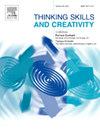Creative spark or overthinking? The synergistic effects of free and controlled associations on creativity
IF 3.7
2区 教育学
Q1 Social Sciences
引用次数: 0
Abstract
This study examines the dual-process role of associative thinking in creative cognition, focusing on the effects of free and controlled associations on divergent thinking (DT), creative self-concept, openness, and creative behavior. A multi-timepoint design collected data from 384 participants at Time 1 (T1) for free and controlled association tasks and DT, and from 267 participants at Time 2 (T2) for creative self-concept, openness, and creative behavior assessments. Structural equation modeling revealed that both associations positively predicted DT originality and switch distance, but controlled association negatively impacted DT fluency. Regression analyses showed that associative abilities did not directly predict creative behaviors and controlled association negatively impacted creative self-efficacy. Instead, these traits were primarily predicted by the quantity of DT responses. Exploratory analyses revealed that the quantity of DT responses mediated the negative impact of T1 controlled association on T2 creative self-efficacy, self-identity, openness, and behavior. On the other hand, the quality of DT responses mediated the positive effect of controlled association on T2 creative behavior. These findings support the dual-process perspective of associative theory and highlight the greater influence of associative processes in the early stages of creative thinking.
创意火花还是过度思考?自由和受控制的联想对创造力的协同效应
本研究探讨了联想思维在创造性认知中的双过程作用,重点探讨了自由联想和受控联想对发散思维、创造性自我概念、开放性和创造性行为的影响。采用多时间点设计,收集384名参与者在时间1 (T1)进行自由和受控联想任务和DT, 267名参与者在时间2 (T2)进行创造性自我概念、开放性和创造性行为评估。结构方程模型显示,两种关联对DT独创性和转换距离均有正向影响,而控制关联对DT流畅性有负向影响。回归分析表明,联想能力不能直接预测创造性行为,而控制联想对创造性自我效能感有负向影响。相反,这些性状主要是由DT响应的数量来预测的。探索性分析发现,DT反应的数量在T1控制关联对T2创造性自我效能、自我同一性、开放性和行为的负向影响中起中介作用。另一方面,DT反应的质量在控制性联想对T2创造性行为的正向影响中起中介作用。这些发现支持了联想理论的双过程观点,并突出了联想过程在创造性思维早期阶段的更大影响。
本文章由计算机程序翻译,如有差异,请以英文原文为准。
求助全文
约1分钟内获得全文
求助全文
来源期刊

Thinking Skills and Creativity
EDUCATION & EDUCATIONAL RESEARCH-
CiteScore
6.40
自引率
16.20%
发文量
172
审稿时长
76 days
期刊介绍:
Thinking Skills and Creativity is a new journal providing a peer-reviewed forum for communication and debate for the community of researchers interested in teaching for thinking and creativity. Papers may represent a variety of theoretical perspectives and methodological approaches and may relate to any age level in a diversity of settings: formal and informal, education and work-based.
 求助内容:
求助内容: 应助结果提醒方式:
应助结果提醒方式:


